Competitive Strategies of Pepsi and Coca-Cola: A Strategic Analysis
VerifiedAdded on 2020/07/23
|6
|1391
|361
Report
AI Summary
This report provides a strategic analysis of the competitive landscape between PepsiCo and Coca-Cola, often referred to as the 'Cold War' in the beverage industry. It examines the application of Porter's Five Forces, PESTLE analysis, and VRIN analysis to understand the external and internal factors influencing their strategies. The report explores how both companies have focused on improving production processes, marketing campaigns, and pricing strategies to gain market share. Furthermore, it delves into their corporate social responsibility initiatives and corporate strategies, including supply chain management and resource utilization. The analysis covers their responses to each other's marketing moves, including campaigns, advertisements and social media presence, offering a comprehensive view of their strategic rivalry and providing valuable insights into the dynamics of the food and beverage industry.
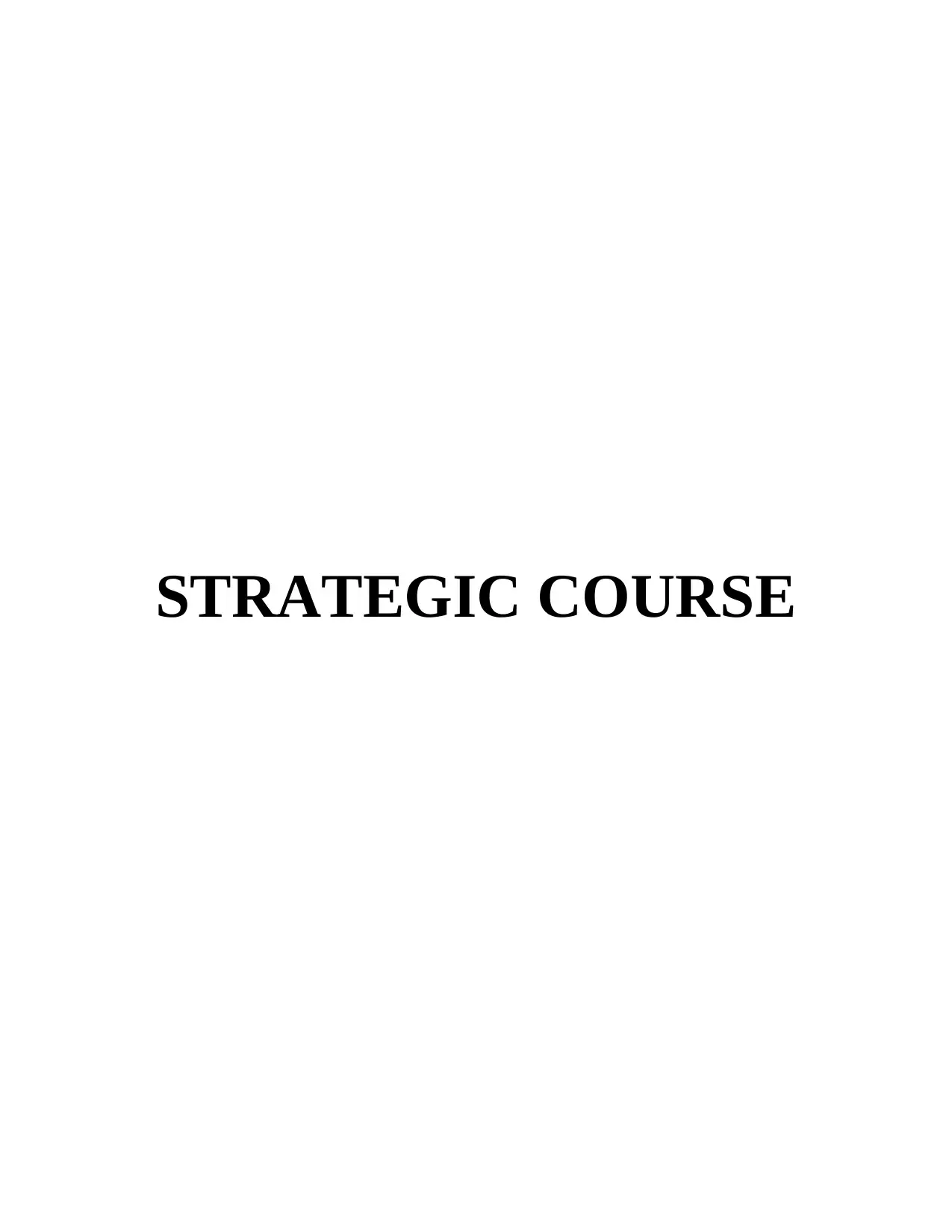
STRATEGIC COURSE
Paraphrase This Document
Need a fresh take? Get an instant paraphrase of this document with our AI Paraphraser
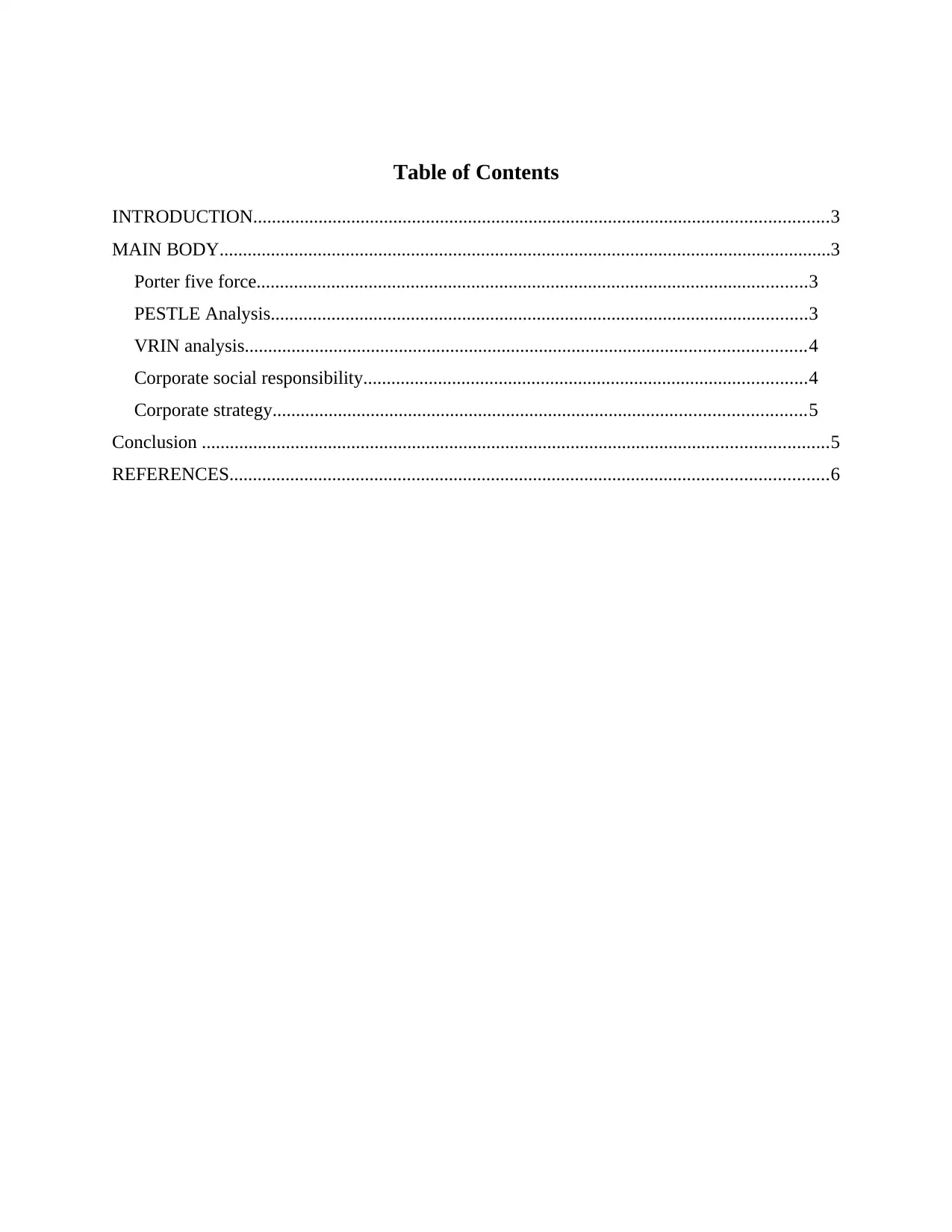
Table of Contents
INTRODUCTION...........................................................................................................................3
MAIN BODY...................................................................................................................................3
Porter five force......................................................................................................................3
PESTLE Analysis...................................................................................................................3
VRIN analysis........................................................................................................................4
Corporate social responsibility...............................................................................................4
Corporate strategy..................................................................................................................5
Conclusion ......................................................................................................................................5
REFERENCES................................................................................................................................6
INTRODUCTION...........................................................................................................................3
MAIN BODY...................................................................................................................................3
Porter five force......................................................................................................................3
PESTLE Analysis...................................................................................................................3
VRIN analysis........................................................................................................................4
Corporate social responsibility...............................................................................................4
Corporate strategy..................................................................................................................5
Conclusion ......................................................................................................................................5
REFERENCES................................................................................................................................6
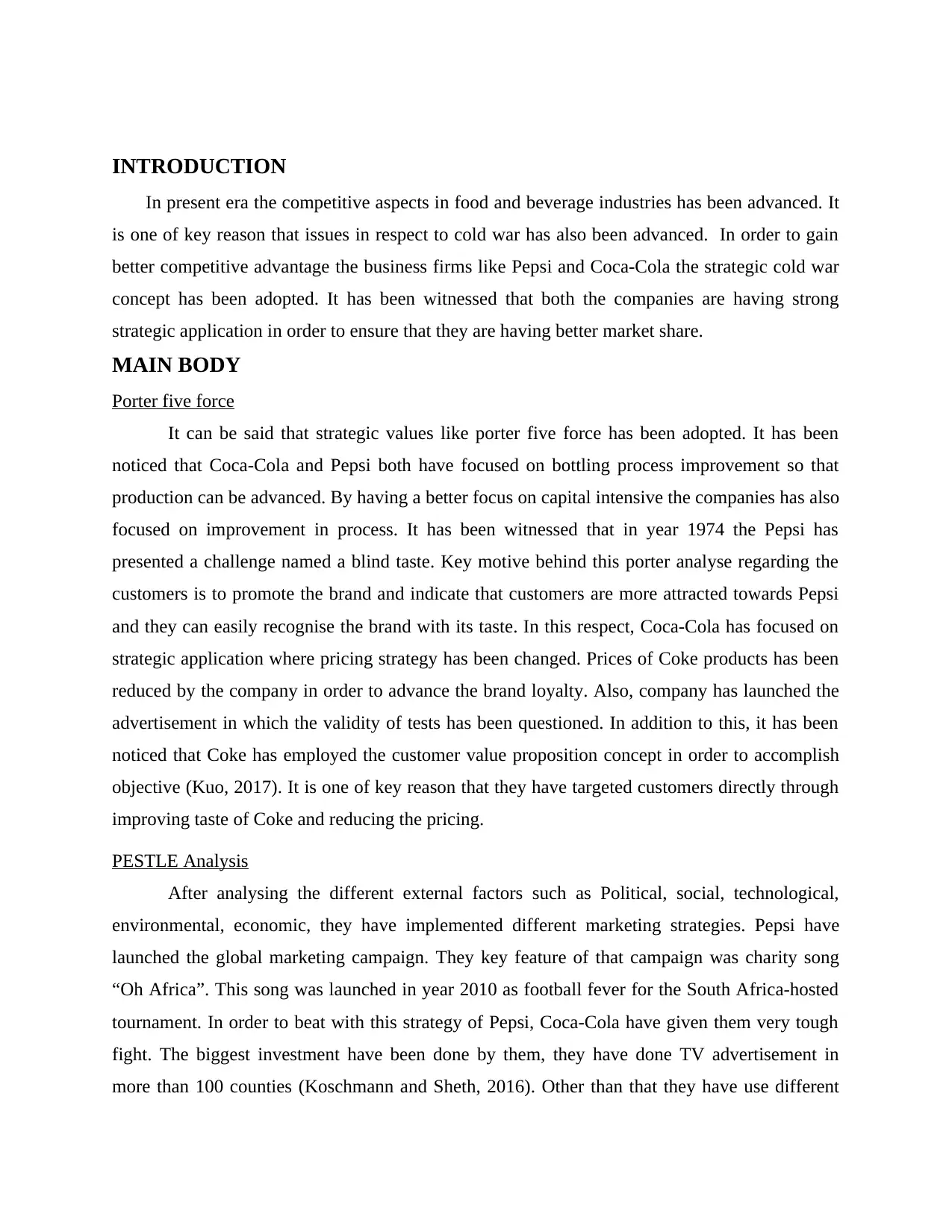
INTRODUCTION
In present era the competitive aspects in food and beverage industries has been advanced. It
is one of key reason that issues in respect to cold war has also been advanced. In order to gain
better competitive advantage the business firms like Pepsi and Coca-Cola the strategic cold war
concept has been adopted. It has been witnessed that both the companies are having strong
strategic application in order to ensure that they are having better market share.
MAIN BODY
Porter five force
It can be said that strategic values like porter five force has been adopted. It has been
noticed that Coca-Cola and Pepsi both have focused on bottling process improvement so that
production can be advanced. By having a better focus on capital intensive the companies has also
focused on improvement in process. It has been witnessed that in year 1974 the Pepsi has
presented a challenge named a blind taste. Key motive behind this porter analyse regarding the
customers is to promote the brand and indicate that customers are more attracted towards Pepsi
and they can easily recognise the brand with its taste. In this respect, Coca-Cola has focused on
strategic application where pricing strategy has been changed. Prices of Coke products has been
reduced by the company in order to advance the brand loyalty. Also, company has launched the
advertisement in which the validity of tests has been questioned. In addition to this, it has been
noticed that Coke has employed the customer value proposition concept in order to accomplish
objective (Kuo, 2017). It is one of key reason that they have targeted customers directly through
improving taste of Coke and reducing the pricing.
PESTLE Analysis
After analysing the different external factors such as Political, social, technological,
environmental, economic, they have implemented different marketing strategies. Pepsi have
launched the global marketing campaign. They key feature of that campaign was charity song
“Oh Africa”. This song was launched in year 2010 as football fever for the South Africa-hosted
tournament. In order to beat with this strategy of Pepsi, Coca-Cola have given them very tough
fight. The biggest investment have been done by them, they have done TV advertisement in
more than 100 counties (Koschmann and Sheth, 2016). Other than that they have use different
In present era the competitive aspects in food and beverage industries has been advanced. It
is one of key reason that issues in respect to cold war has also been advanced. In order to gain
better competitive advantage the business firms like Pepsi and Coca-Cola the strategic cold war
concept has been adopted. It has been witnessed that both the companies are having strong
strategic application in order to ensure that they are having better market share.
MAIN BODY
Porter five force
It can be said that strategic values like porter five force has been adopted. It has been
noticed that Coca-Cola and Pepsi both have focused on bottling process improvement so that
production can be advanced. By having a better focus on capital intensive the companies has also
focused on improvement in process. It has been witnessed that in year 1974 the Pepsi has
presented a challenge named a blind taste. Key motive behind this porter analyse regarding the
customers is to promote the brand and indicate that customers are more attracted towards Pepsi
and they can easily recognise the brand with its taste. In this respect, Coca-Cola has focused on
strategic application where pricing strategy has been changed. Prices of Coke products has been
reduced by the company in order to advance the brand loyalty. Also, company has launched the
advertisement in which the validity of tests has been questioned. In addition to this, it has been
noticed that Coke has employed the customer value proposition concept in order to accomplish
objective (Kuo, 2017). It is one of key reason that they have targeted customers directly through
improving taste of Coke and reducing the pricing.
PESTLE Analysis
After analysing the different external factors such as Political, social, technological,
environmental, economic, they have implemented different marketing strategies. Pepsi have
launched the global marketing campaign. They key feature of that campaign was charity song
“Oh Africa”. This song was launched in year 2010 as football fever for the South Africa-hosted
tournament. In order to beat with this strategy of Pepsi, Coca-Cola have given them very tough
fight. The biggest investment have been done by them, they have done TV advertisement in
more than 100 counties (Koschmann and Sheth, 2016). Other than that they have use different
⊘ This is a preview!⊘
Do you want full access?
Subscribe today to unlock all pages.

Trusted by 1+ million students worldwide
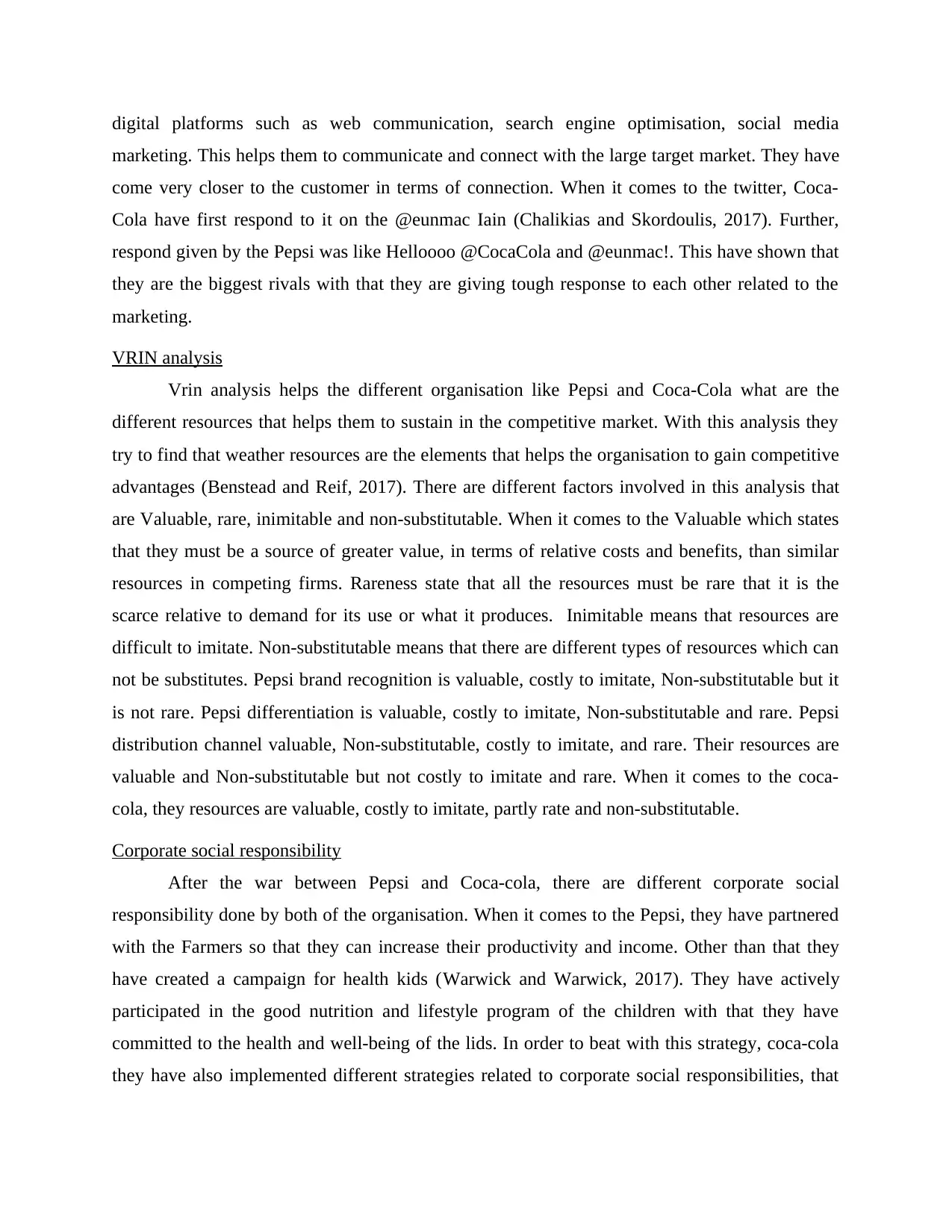
digital platforms such as web communication, search engine optimisation, social media
marketing. This helps them to communicate and connect with the large target market. They have
come very closer to the customer in terms of connection. When it comes to the twitter, Coca-
Cola have first respond to it on the @eunmac Iain (Chalikias and Skordoulis, 2017). Further,
respond given by the Pepsi was like Helloooo @CocaCola and @eunmac!. This have shown that
they are the biggest rivals with that they are giving tough response to each other related to the
marketing.
VRIN analysis
Vrin analysis helps the different organisation like Pepsi and Coca-Cola what are the
different resources that helps them to sustain in the competitive market. With this analysis they
try to find that weather resources are the elements that helps the organisation to gain competitive
advantages (Benstead and Reif, 2017). There are different factors involved in this analysis that
are Valuable, rare, inimitable and non-substitutable. When it comes to the Valuable which states
that they must be a source of greater value, in terms of relative costs and benefits, than similar
resources in competing firms. Rareness state that all the resources must be rare that it is the
scarce relative to demand for its use or what it produces. Inimitable means that resources are
difficult to imitate. Non-substitutable means that there are different types of resources which can
not be substitutes. Pepsi brand recognition is valuable, costly to imitate, Non-substitutable but it
is not rare. Pepsi differentiation is valuable, costly to imitate, Non-substitutable and rare. Pepsi
distribution channel valuable, Non-substitutable, costly to imitate, and rare. Their resources are
valuable and Non-substitutable but not costly to imitate and rare. When it comes to the coca-
cola, they resources are valuable, costly to imitate, partly rate and non-substitutable.
Corporate social responsibility
After the war between Pepsi and Coca-cola, there are different corporate social
responsibility done by both of the organisation. When it comes to the Pepsi, they have partnered
with the Farmers so that they can increase their productivity and income. Other than that they
have created a campaign for health kids (Warwick and Warwick, 2017). They have actively
participated in the good nutrition and lifestyle program of the children with that they have
committed to the health and well-being of the lids. In order to beat with this strategy, coca-cola
they have also implemented different strategies related to corporate social responsibilities, that
marketing. This helps them to communicate and connect with the large target market. They have
come very closer to the customer in terms of connection. When it comes to the twitter, Coca-
Cola have first respond to it on the @eunmac Iain (Chalikias and Skordoulis, 2017). Further,
respond given by the Pepsi was like Helloooo @CocaCola and @eunmac!. This have shown that
they are the biggest rivals with that they are giving tough response to each other related to the
marketing.
VRIN analysis
Vrin analysis helps the different organisation like Pepsi and Coca-Cola what are the
different resources that helps them to sustain in the competitive market. With this analysis they
try to find that weather resources are the elements that helps the organisation to gain competitive
advantages (Benstead and Reif, 2017). There are different factors involved in this analysis that
are Valuable, rare, inimitable and non-substitutable. When it comes to the Valuable which states
that they must be a source of greater value, in terms of relative costs and benefits, than similar
resources in competing firms. Rareness state that all the resources must be rare that it is the
scarce relative to demand for its use or what it produces. Inimitable means that resources are
difficult to imitate. Non-substitutable means that there are different types of resources which can
not be substitutes. Pepsi brand recognition is valuable, costly to imitate, Non-substitutable but it
is not rare. Pepsi differentiation is valuable, costly to imitate, Non-substitutable and rare. Pepsi
distribution channel valuable, Non-substitutable, costly to imitate, and rare. Their resources are
valuable and Non-substitutable but not costly to imitate and rare. When it comes to the coca-
cola, they resources are valuable, costly to imitate, partly rate and non-substitutable.
Corporate social responsibility
After the war between Pepsi and Coca-cola, there are different corporate social
responsibility done by both of the organisation. When it comes to the Pepsi, they have partnered
with the Farmers so that they can increase their productivity and income. Other than that they
have created a campaign for health kids (Warwick and Warwick, 2017). They have actively
participated in the good nutrition and lifestyle program of the children with that they have
committed to the health and well-being of the lids. In order to beat with this strategy, coca-cola
they have also implemented different strategies related to corporate social responsibilities, that
Paraphrase This Document
Need a fresh take? Get an instant paraphrase of this document with our AI Paraphraser
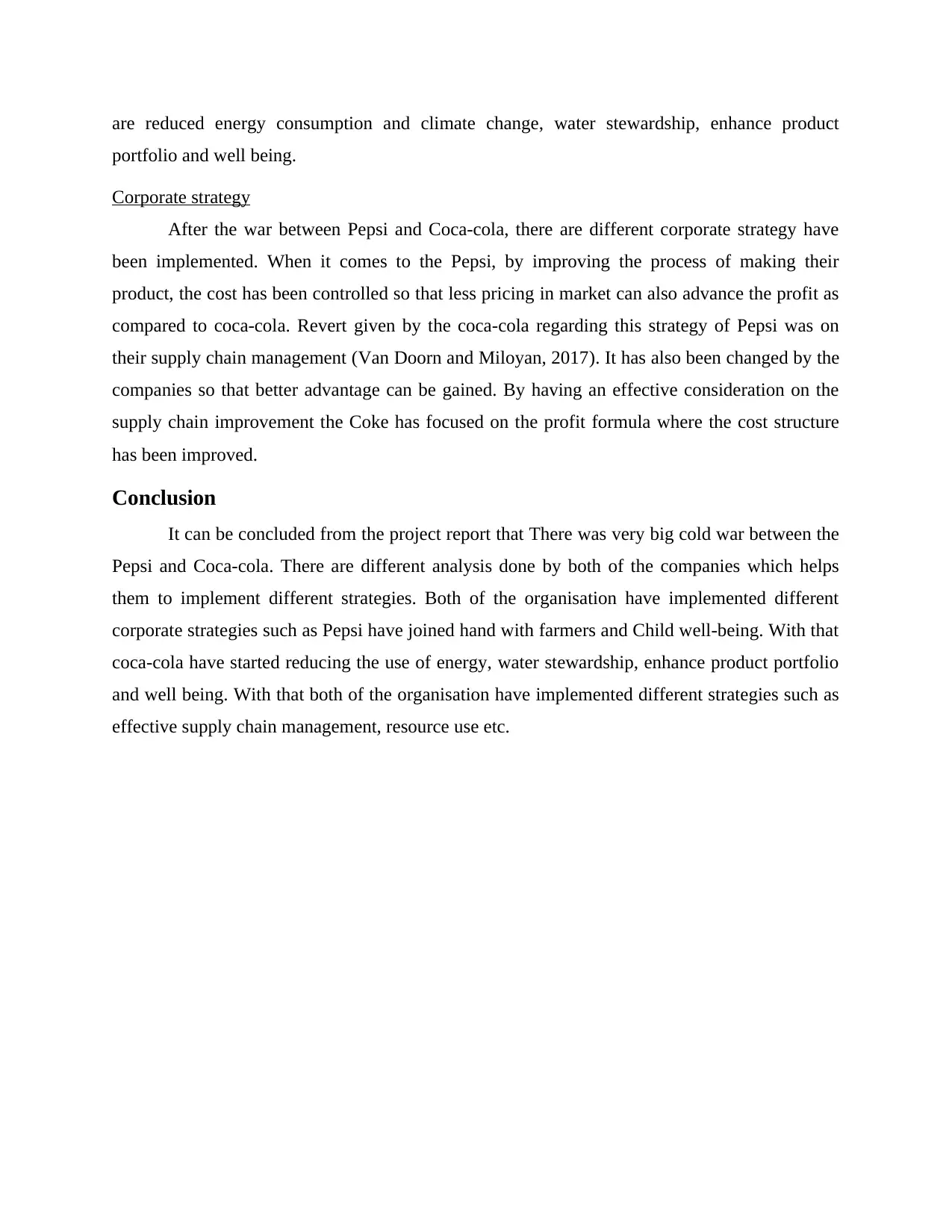
are reduced energy consumption and climate change, water stewardship, enhance product
portfolio and well being.
Corporate strategy
After the war between Pepsi and Coca-cola, there are different corporate strategy have
been implemented. When it comes to the Pepsi, by improving the process of making their
product, the cost has been controlled so that less pricing in market can also advance the profit as
compared to coca-cola. Revert given by the coca-cola regarding this strategy of Pepsi was on
their supply chain management (Van Doorn and Miloyan, 2017). It has also been changed by the
companies so that better advantage can be gained. By having an effective consideration on the
supply chain improvement the Coke has focused on the profit formula where the cost structure
has been improved.
Conclusion
It can be concluded from the project report that There was very big cold war between the
Pepsi and Coca-cola. There are different analysis done by both of the companies which helps
them to implement different strategies. Both of the organisation have implemented different
corporate strategies such as Pepsi have joined hand with farmers and Child well-being. With that
coca-cola have started reducing the use of energy, water stewardship, enhance product portfolio
and well being. With that both of the organisation have implemented different strategies such as
effective supply chain management, resource use etc.
portfolio and well being.
Corporate strategy
After the war between Pepsi and Coca-cola, there are different corporate strategy have
been implemented. When it comes to the Pepsi, by improving the process of making their
product, the cost has been controlled so that less pricing in market can also advance the profit as
compared to coca-cola. Revert given by the coca-cola regarding this strategy of Pepsi was on
their supply chain management (Van Doorn and Miloyan, 2017). It has also been changed by the
companies so that better advantage can be gained. By having an effective consideration on the
supply chain improvement the Coke has focused on the profit formula where the cost structure
has been improved.
Conclusion
It can be concluded from the project report that There was very big cold war between the
Pepsi and Coca-cola. There are different analysis done by both of the companies which helps
them to implement different strategies. Both of the organisation have implemented different
corporate strategies such as Pepsi have joined hand with farmers and Child well-being. With that
coca-cola have started reducing the use of energy, water stewardship, enhance product portfolio
and well being. With that both of the organisation have implemented different strategies such as
effective supply chain management, resource use etc.
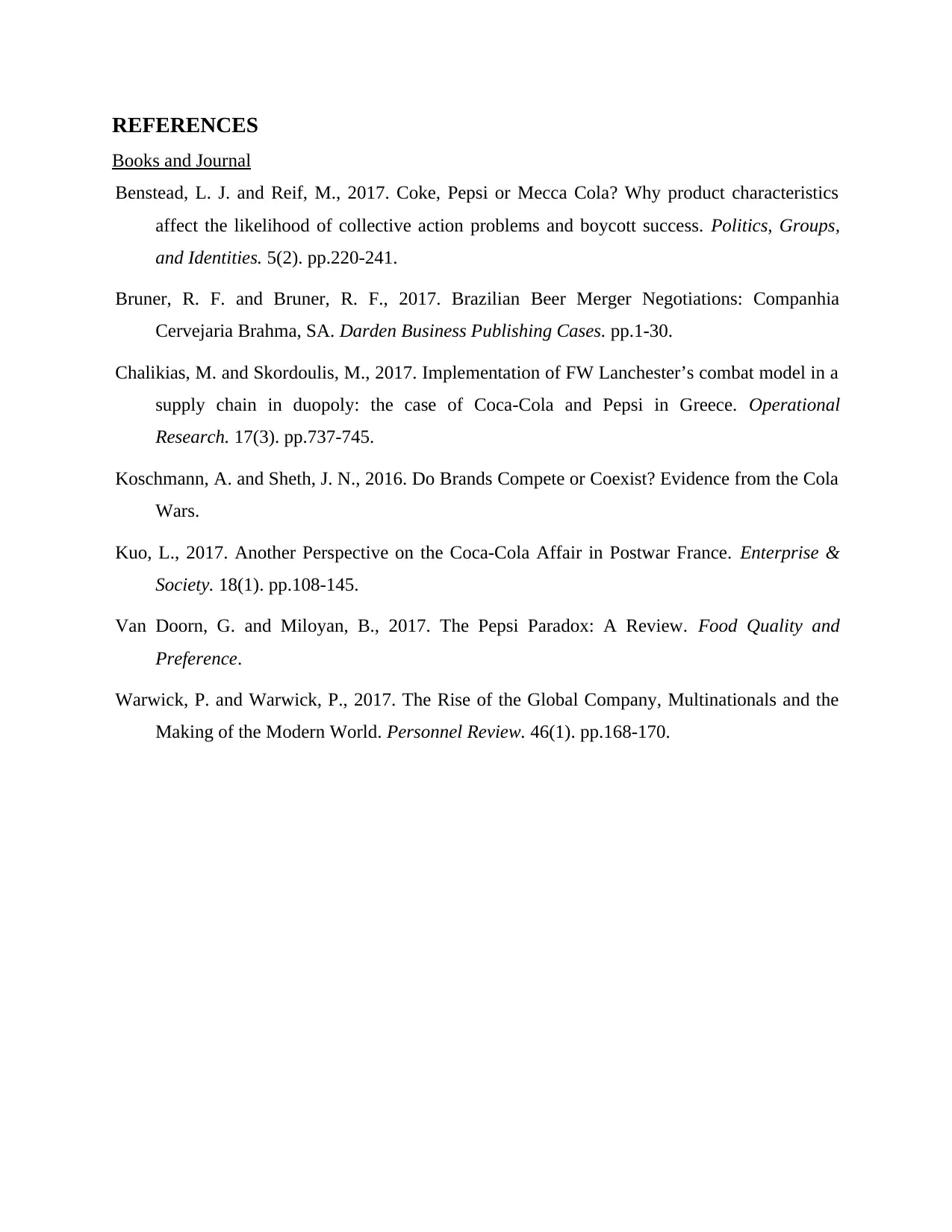
REFERENCES
Books and Journal
Benstead, L. J. and Reif, M., 2017. Coke, Pepsi or Mecca Cola? Why product characteristics
affect the likelihood of collective action problems and boycott success. Politics, Groups,
and Identities. 5(2). pp.220-241.
Bruner, R. F. and Bruner, R. F., 2017. Brazilian Beer Merger Negotiations: Companhia
Cervejaria Brahma, SA. Darden Business Publishing Cases. pp.1-30.
Chalikias, M. and Skordoulis, M., 2017. Implementation of FW Lanchester’s combat model in a
supply chain in duopoly: the case of Coca-Cola and Pepsi in Greece. Operational
Research. 17(3). pp.737-745.
Koschmann, A. and Sheth, J. N., 2016. Do Brands Compete or Coexist? Evidence from the Cola
Wars.
Kuo, L., 2017. Another Perspective on the Coca-Cola Affair in Postwar France. Enterprise &
Society. 18(1). pp.108-145.
Van Doorn, G. and Miloyan, B., 2017. The Pepsi Paradox: A Review. Food Quality and
Preference.
Warwick, P. and Warwick, P., 2017. The Rise of the Global Company, Multinationals and the
Making of the Modern World. Personnel Review. 46(1). pp.168-170.
Books and Journal
Benstead, L. J. and Reif, M., 2017. Coke, Pepsi or Mecca Cola? Why product characteristics
affect the likelihood of collective action problems and boycott success. Politics, Groups,
and Identities. 5(2). pp.220-241.
Bruner, R. F. and Bruner, R. F., 2017. Brazilian Beer Merger Negotiations: Companhia
Cervejaria Brahma, SA. Darden Business Publishing Cases. pp.1-30.
Chalikias, M. and Skordoulis, M., 2017. Implementation of FW Lanchester’s combat model in a
supply chain in duopoly: the case of Coca-Cola and Pepsi in Greece. Operational
Research. 17(3). pp.737-745.
Koschmann, A. and Sheth, J. N., 2016. Do Brands Compete or Coexist? Evidence from the Cola
Wars.
Kuo, L., 2017. Another Perspective on the Coca-Cola Affair in Postwar France. Enterprise &
Society. 18(1). pp.108-145.
Van Doorn, G. and Miloyan, B., 2017. The Pepsi Paradox: A Review. Food Quality and
Preference.
Warwick, P. and Warwick, P., 2017. The Rise of the Global Company, Multinationals and the
Making of the Modern World. Personnel Review. 46(1). pp.168-170.
⊘ This is a preview!⊘
Do you want full access?
Subscribe today to unlock all pages.

Trusted by 1+ million students worldwide
1 out of 6
Related Documents
Your All-in-One AI-Powered Toolkit for Academic Success.
+13062052269
info@desklib.com
Available 24*7 on WhatsApp / Email
![[object Object]](/_next/static/media/star-bottom.7253800d.svg)
Unlock your academic potential
Copyright © 2020–2025 A2Z Services. All Rights Reserved. Developed and managed by ZUCOL.





